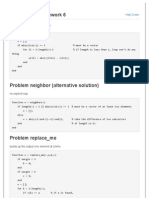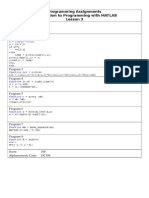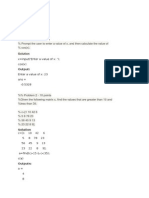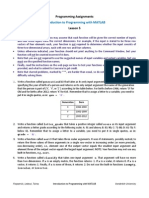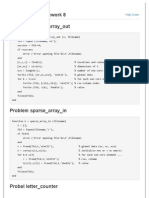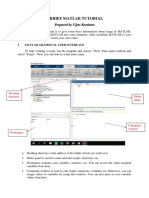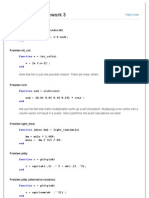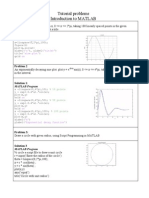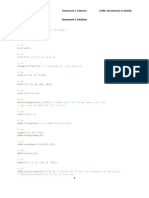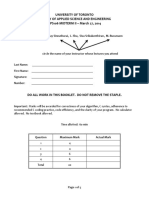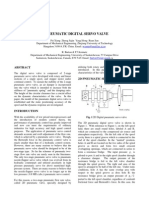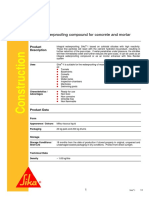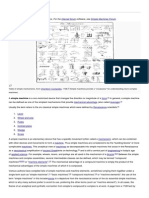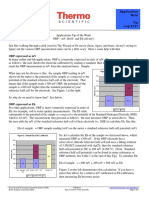Solutions to Homework 3
Problem odd_index:
function out = odd_index(M)
out = M(1:2:end, 1:2:end);
end
Problem int_col:
function v = int_col(n)
v = [n 1:n-1]';
end
Note that this is just one possible solution. There are many others.
Problem rich:
function usd = rich(cent)
usd = [0.01 0.05 0.10 0.25] * cent';
end
We use the fact that matrix multiplication sums up a set of products. Multiplying a row
vector with a column vector will result in a scalar. Here it performs the exact calculations
we need.
Problem light_time:
function [mins km] = light_time(mile)
km = mile * 1.609;
mins = km / 3e5 / 60;
end
Problem pitty:
function c = pitty(ab)
c = sqrt(ab(:,1) .^ 2 + ab(:,2) .^2);
end
�Problem pitty (alternative solution):
function c = pitty(ab)
c = sqrt(sum(ab' .^ 2))';
end
Here we use the fact that the function sum works column by column. So, transposing and
then squaring every element will put the squares of the corresponding a-s and b-s into
columns. The function sum then adds them up, and sqrt computes each element's
square root. Finally, we need to transpose the result back into a column vector.
Problem bottom_left:
function M = bottom_left(N,n)
M = N(end-n+1:end, 1:n);
end
We need the last n rows and the first n columns. The only trick here is that we need endn+1, because end-n:end would get us n+1 indexes and not n as required.
Problem mean_squares:
function mm = mean_squares(nn)
mm = mean((1:nn).^2);
end
Problem hulk:
function H = hulk(v)
H = [v' (v').^2 (v').^3];
end
�Solutions to Homework 4
Problem quadrants:
function Q = quadrants(n)
a = ones(n);
Q = [a 2*a ; 3*a 4*a];
end
Problem checkerboard:
function b = checkerboard(n,m)
b = ones(n,m);
b(1:2:n,2:2:m) = 0;
b(2:2:n,1:2:m) = 0;
end
Problem randomness:
function r = randomness(limit,n,m)
r = fix(limit * rand(n,m)) + 1;
end
Problem mtable:
function [t s] = mtable(n,m)
t = (1:n)' * (1:m);
s = sum(t(:));
end
If we matrix multiply a column vector of length N by a row vector of length M, each
element of the resulting N-by-M matrix will be the product of one element from each
vector. Therefore, we can create a multiplication table by setting the column vector to 1:N
and the row vector to 1:M and using matrix multiplication.
�Problem identity:
function I = identity(n)
I = zeros(n);
I(1 : n+1 : n^2) = 1;
end
Here we index into a matrix with a single index and MATLAB handles it as if it was a
vector using column-major order. Putting ones at the first position and jumping n+1 every
time, will put them exactly in the diagonal.
�Solutions to Homework 5
Here are the "official" solutions. Note that there are multiple ways to solve any non-trivial problem,
so these are just representative examples.
Problem generationXYZ
function gen = generationXYZ(year)
if year < 1966
gen = 'O';
elseif year < 1981
gen = 'X';
elseif year < 2000
gen = 'Y';
elseif year < 2013
gen = 'Z';
else
gen = 'K';
end
end
Problem generationXYZ (alternative solution)
Using no if-statements
function gen = generationXYZ(yr)
opts = {'O','X','Y','Z','K'}; % Create cell array of options
idx = 1 + sum(yr >= [1966,1981,2000,2013]); % Calculate index by comparing year
to edge values
gen = opts{idx};
end
�Problem letter_grade
function G = letter_grade(score)
if score >= 91
G = 'A';
elseif score >= 81
G = 'B';
elseif score >= 71
G = 'C';
elseif score >= 61
G = 'D';
else
G = 'F';
end
end
Problem sort3
Using no built-in functions
function v = sort3(a, b, c)
if a <= b
v = [a b];
else
v = [b a];
end
if c >= v(2)
v = [v c];
% a and b in v are ordered. Where to insert c?
% at the end
elseif c <= v(1)
v = [c v];
else
% at the beginning
�v = [v(1) c v(2)]; % in the middle
end
end
Problem sort3
Using no if-statements.
function v = sort3 (a,b,c)
v = [a b c];
% unordered
v = [min(v(1),v(3)) v(2) max(v(1),v(3))]; % the 1st and 3rd are in order
v = [min(v(1),v(2)) max(v(1),v(2)) v(3)]; % move 2nd left if necessary
v = [v(1) min(v(2),v(3)) max(v(2),v(3))]; % move 2nd right if necessary
end
Problem classify
function c = classify(x)
[row, col] = size(x);
if row == 0 || col == 0
% any dim == 0 -> empty
c = -1;
elseif row == 1 && col == 1
% both dim == 1 -> scalar
c = 0;
elseif row == 1 || col == 1
% none of the above, but one dim == 1 -> vector
c = 1;
else
c = 2;
end
end
Problem classify (alternative solution)
function c = classify(x)
mindim = min(size(x));
�maxdim = max(size(x));
if mindim == 0
% if one dim == 0, it must be empty
c = -1
elseif maxdim == 1 % otherwise, both dim == 1 (since max == 1) -> scalar
c = 0;
elseif mindim == 1 % otherwise, if the smaller dim == 1 -> vector
c = 1;
else
c = 2;
end
end
Problem classify (alternative solution)
Using no if-statements
function y = classify (x)
d = size(x);
p = prod(d);
% multiplies the two dims
y = -1 +(p>=1) +(p>1) +(min(d)>1) % each added condition increases the answer
by one
end
% Note that the first two solutions are longer but easier to read and understand than this
one.
Problem older
function a = older(y1,m1,d1,y2,m2,d2)
a = 1;
if y1 == y2 && m1 == m2 && d1 == d2
a = 0;
elseif (y1 > y2) || (y1 == y2 && m1 > m2) || (y1 == y2 && m1 == m2 && d1 > d2)
�a = -1;
end
end
Problem older (alternative solution)
Using no if-statements
function a = older(y1,m1,d1,y2,m2,d2)
a1 = y1 * 366 + m1 * 31 + d1;
% does not have to be exact date in days...
a2 = y2 * 366 + m2 * 31 + d2;
% it simply makes a1 and a2 comparable
a = sign(a2 - a1);
% sign() returns -1, 0 or 1, just what is needed
end
% multiplying by 366 or greater is needed because of leap years
Problem movies
function cando = movies(hr1,min1,durmin1,hr2,min2,durmin2)
cando = false;
endtime = hr1*60 + min1 + durmin1;
% convert times to minutes
starttime = hr2*60 + min2;
if endtime <= starttime && endtime + 30 >= starttime % so we can compare them
cando = true;
end
end
Problem movies (alternative solution)
Using no if-statement
function cando = movies(h1,m1,d1,h2,m2,d2)
end1 = h1*60 + m1 + d1;
st2 = h2*60 + m2;
�cando = (end1 <= st2 && end1+30 >= st2);
end
Problem sines
function [s1 s2 sums] = sines(pts,amp,f1,f2)
if nargin < 1, pts = 1000;
end
if nargin < 2, amp = 1;
end
if nargin < 3, f1 = 100;
end
if nargin < 4, f2 = f1*1.05; end
t = 0 : 2*pi/(pts-1) : 2*pi;
s1 = amp * sin(f1*t);
s2 = amp * sin(f2*t);
sums = s1 + s2;
end
% The sin() function has a full period between 0 and 2*pi.
% To set up the vector t, dividing by (pts-1) is needed
% because n points in a line define (n-1) consecutive segments
% and not n. For example, two points define a single line segment.
% The function call sin(f1*t) will create exactly f1 full periods
% using vector t defined above.
Problem moving average
function a = moving_average(x)
persistent xp;
if isempty(xp)
xp = x;
% first time, the buffer simply contains x
elseif length(xp) < 25
xp(end+1) = x;
else
% while fewer than 25 elements, keep adding x to the buffer
�xp = [xp(2:end),x];
end
% replace first (oldest) element by shifting to the left
% and inserting x at the end
a = mean(xp);
end
Problem moving average (alternative solution)
Using no if-statement
function avg = moving_average (in)
persistent buffer;
buffer = [in buffer(1:end-(length(buffer) == 25))];
avg = mean(buffer);
end
% This is an illustration of a short, but tricky solution. However,
% a longer, but more readable solution is always preferred, therefore,
% the first solution is better!
%
% This one works by realizing that we do not need to check whether the
% buffer is empty or not, since [x buffer] will work either way.
% The tricky part is how the length is handled. While the buffer is
% shorter than 25, buffer(1:end) is used. Once it reaches 25, it turns
% into buffer(1:end-1), exactly what is needed.
�Solutions to Homework 6
Problem neighbor
function w = neighbor(v)
w = [];
if min(size(v)) == 1
% must be a vector
for ii = 1:length(v)-1
% if length is less than 2, loop won't do anything
w(ii) = abs(v(ii+1) - v(ii));
end
end
end
Problem neighbor (alternative solution)
no explicit loop
function w = neighbor(v)
if length(v) < 2 || min(size(v)) ~= 1 % must be a vector of at least two elements
w = [];
else
w = abs(v(1:end-1)-v(2:end));
end
% take the difference of two subvectors
% of length (n-1)
end
Problem replace_me
builds up the output one element at a time
function w = replace_me(v,a,b,c)
if nargin < 3
b = 0;
�end
if nargin < 4
c = b;
end
w = [];
for k = 1:length(v);
if v(k) == a
% if a is found,
w = [w,b,c];
else
% we insert b and c at the end of the current w
% otherwise,
w = [w,v(k)]; % we insert the original element of v
end
end
end
Problem replace_me (alternative solution)
only changes the output vector when an instance of a is found
function w = replace_me(v,a,b,c)
if nargin < 3
b = 0;
end
if nargin < 4
c = b;
end
w = v;
% make w the same as v
wi = 1;
% wi is used to index into w
for vi = 1:length(v)
if v(vi) == a
w = [w(1:wi-1) b c w(wi+1:end)];
wi = wi + 1;
% insert b and c at position wi
% increment wi
�end
wi = wi + 1;
% wi is incremented in either case
end
end
Problem halfsum
using nested loops
function s = halfsum(A)
[row col] = size(A);
s = 0;
for ii = 1:row
for jj = ii:col
% the column index only starts at the current row index
s = s + A(ii,jj);
end
end
end
Problem halfsum (alternative solution)
using a single loop and sum
function s = halfsum(A)
[nr,~] = size(A);
s = 0;
for r = 1:nr
% for each row
s = s + sum(A(r,r:end));
% sum adds up the elements right of the diagonal
(inclusive)
end
% in the current row
end
Problem large_elements
function found = large_element(A)
�[row col] = size(A);
found = [];
for ii = 1:row
for jj = 1:col
if A(ii,jj) > ii + jj
% if the element is larger than the sum of its indexes
found = [found; ii jj]; % add a new row to the output matrix
end
end
end
end
problem one_per_n
using while-loop
function n = one_per_n(x)
n = 0;
sum = 0;
while sum < x && n <= 10000
n = n + 1;
sum = sum + 1/n;
end
if n > 10000
n = -1;
end
end
problem one_per_n (alternative solution)
using for-loop
function n = one_per_n(x)
s = 0;
�for n = 1:1e4
s = s + 1/n;
if s >= x
return;
end
end
n = -1;
end
Problem approximate_pi
function [a,k] = approximate_pi(delta)
k = 0;
f = sqrt(12);
a = f;
% compute sqrt(12) only once
% the value of a for k == 0
while abs(pi-a) > delta
k = k + 1;
% while we are further away than delta
% increment k
a = a + f*(-3)^(-k)/(2*k+1);
% add increment to current value of a
end
end
Problem separate_by_two
using division and rounding
function [even,odd] = separate_by_two(A)
even = A(fix(A/2) == A/2)'; % if A is even, rounding does not do anything to A/2
odd = A(fix(A/2) ~= A/2)'; % if A is odd, it gets rid of the .5 part, so they won't be
equal
end
% note that this will put non-integers into odd
�Problem separate_by_two (alternative solution)
using mod (or rem)
function [even, odd] = separate_by_two(A)
even = A(mod(A,2) == 0)'; % mod gives 0 if even
odd = A(mod(A,2) == 1)'; % mod gives 1 if odd
end
% note that this one will not put non-integers in any of the outputs
Problem separate_by_two (alternative
solution)
using mod (or rem)
function [even,odd] = separate_by_two(A)
mod2 = logical(mod(A,2));
even = A(~mod2)';
% modulo 2 is zero for even numbers (logical false), so we
need to negate it
odd = A(mod2)';
% modulo 2 is non-zero for odd numbers, that is, logical true
end
% note that this will put non-integers into odd
Problem divvy
function A = divvy (A,k)
L = (mod(A,k) ~= 0);
A(L) = k * A(L);
% creates a logical matrix based on divisibility by k
% changes only the non-divisible elements of A by multiplying
them by k
end
% uses A as both input and output, so we only need to modify some elements of A
�Problem divvy (alternative solution)
single line solution
function I = divvy(I,k)
I(mod(I,k) ~= 0) = I(mod(I,k) ~= 0) * k;
end
% same solution as above, but it repeats the modulo computation
Problem square_wave
using a for-loop
function sq = square_wave(n)
t = 0 : 4*pi/1000 : 4*pi;
% setup vector according to the specs
sq = zeros(1,length(t));
% initialize output to 0
for ii = 1:2:2*n
% run for first n odd numbers (2k-1)
sq = sq + cos(ii*t-pi/2)/ii;
% add the next cosine term
end
end
Problem square_wave (alternative solution)
tricky code with no explicit loops
function s = square_wave(n)
t = 0 : 4*pi/1000 : 4*pi; % setup vector according to the specs
idx = (2*(1:n)' - 1);
% make column vector of fist n odd numbers (2k-1)
% idx*t makes a matrix; each row is (2k-1)*t, for a given k
% idx*ones(size(t)) also makes a matrix; each element of row k is just (2k-1)
% sum down the columns
s = sum(sin(idx*t) ./ (idx*ones(size(t))),1);
end
�% the second argument to sum is needed in case n is 1
% remember that sum(x) sums x along columns unless x is a row vector!
Problem my_prime
using a for-loop
function a = myprime(n)
a = false;
if n > 1
% 1 is by definition not prime
for ii = 2:sqrt(n)
% see explanation below
if ~mod(n,ii)
return;
end
end
a = true;
end
end
% x is prime if it is NOT divisible by all integers from 2 to sqrt(x)
% because factors have to come in pairs -- one bigger than sqrt(x) and
% one smaller (or both equal)
Problem my_prime (alternative solution)
with no explicit loops
function prim = myprime(p)
v = 2:sqrt(p);
v = v(rem(p,v) == 0);
% if p is prime, none of the remainders can be 0
prim = ~length(v) && (p ~= 1); % so if v has any elements, p is not prime
end
% 1 is handled by the (p ~= 1) condition
�Solutions to Homework 7
Problem integerize
traditional solution with a single if-elseif-statement
function name = integerize(A)
mx = max(A(:));
name = 'NONE';
if mx <= intmax('uint8')
name = 'uint8';
elseif mx <= intmax('uint16')
name = 'uint16';
elseif mx <= intmax('uint32')
name = 'uint32';
elseif mx < intmax('uint64')
name = 'uint64';
end
end
Problem integerize (alternative solution)
using a cell vector of strings and a for-loop instead
function cl = integerize(A)
cls = {'uint8'; 'uint16'; 'uint32'; 'uint64'};
cl = 'NONE';
mx = max(A(:));
for ii = 1:length(cls)
if intmax(cls{ii}) >= mx
cl = cls{ii};
�break;
end
end
end
Problem integerize (alternative solution)
using a cell vector of strings and vector indexing instead
function iclass = integerize(A)
c = {'uint8','uint16','uint32','uint64','NONE'};
% Array of maximum values for each class
x = 2.^[8,16,32,64] - 1;
% Index into names, based on size of largest element of A
iclass = c{sum(max(A(:))>x)+1};
end
Problem May2015
function sub_May2015
days = ['Thu'; 'Fri'; 'Sat'; 'Sun'; 'Mon'; 'Tue'; 'Wed' ];
for ii = 1:31
m(ii).month = 'May';
m(ii).date = ii;
m(ii).day = days(rem(ii,7)+1,:); % +1 is needed because 0 is an invalid index
end
end
Problem June2015
traditional solution with a for-loop
function m = June2015
days = [ 'Sun'; 'Mon'; 'Tue'; 'Wed'; 'Thu'; 'Fri'; 'Sat'];
�for ii = 1:30
m{ii,1} = 'June';
m{ii,2} = ii;
m{ii,3} = days(rem(ii,7)+1,:);
end
end
Problem June2015 (alternative solution)
using MATLAB built-in functions instead
function x = June2015
% Make vector of dates for June 2015
t = datetime(2015,6,1:30);
% Make a cell array from the components of t
x = cat(1,month(t,'name'),num2cell(day(t)),day(t,'shortname'))';
end
Problem codeit
traditional solution, looking at one char at a time
function out = codeit(in)
for ii = 1:length(in)
if in(ii) <= 'z' && in(ii) >= 'a'
out(ii) = 'a' + 'z' - in(ii);
% lower case
% encrypt it
elseif in(ii) <= 'Z' && in(ii) >= 'A' % upper case
out(ii) = 'A' + 'Z' - in(ii);
else
out(ii) = in(ii);
end
end
end
% encrypt it
% everything else
% no change needed
�Problem codeit (alternative solution)
using logical indexing instead, the input and the output arguments are the same
function txt = codeit (txt)
U = txt > 64 & txt < 91;
% identify uppercase
L = txt > 96 & txt < 123; % identify lowercase
txt(U) = char(155-txt(U)); % encrypt uppercase
txt(L) = char(219-txt(L)); % encrypt lowercase
end
Problem dial
translating the actual requirements straight to code works, but it is pretty long and somewhat
awkward
function ph = dial(str)
code = {'ABC'; 'DEF'; 'GHI'; 'JKL'; 'MNO'; 'PRS'; 'TUV'; 'WXY'};
ph = str;
% set the output to the input
for ii = 1:length(str)
c = str(ii);
% the current char from the input
if c == ' ' || c == '-' || c == '(' || c == ')'
ph(ii) = ' ';
% these characters need to turn into spaces
continue;
elseif (c >= '0' && c <= '9') || c == '#' || c == '*'
continue;
% these need to remain unchanged
else
n = -1;
for jj = 1:length(code)
if ~isempty(strfind(code{jj},c)) % looking for legal letters
n = jj + 1;
break;
% Found it! ABC on the dial maps to 2 not 1, hence the +1
�end
end
if n == -1
ph = [];
% if we did not find a valid letter
% need to return []
return;
end
ph(ii) = char('0' + n); % otherwise, add the char for the right number
end
end
end
Problem dial (alternative solution)
no loop and a single if-statement
function ph = dial(str)
% the variable code has the characters' required mapping starting from space, ending
with Y
% x is for illegal input (e.g., see how Q maps to x in-between 7-s)
code = ' xx#xxxx *xx xx0123456789xxxxxxx2223334445556667x77888999';
ph = [];
% default return value in case of illegal input
n = str-' '+1; % creates a vector of indexes into code from the input characters
% the first two sum()-s check for out-of-range input (smaller than space or larger than
Y)
% the third sum() checks for any input char mapping to x, that is, illegal input
if ~((sum(n <= 0) + sum(n > length(code))) || sum(code(n) == 'x'))
ph = code(n); % a single assignment does the actual transformation of the input
string
end
end
�Problem replace
using a for-loop and logical indexing
function strs = replace(strs,c1,c2);
for ii=1:length(strs)
strs{ii}(strs{ii} == c1) = c2;
% for each string in the cell vector
% replace all c1-s with c2-s at once
end
end
Problem roman
problem size is small, so it is easier to simply enumerate all 20 numbers
function num = roman(rom)
romans = { 'I' 'II' 'III' 'IV' 'V' 'VI' 'VII' 'VIII' 'IX' 'X' ...
'XI' 'XII' 'XIII' 'XIV' 'XV' 'XVI' 'XVII' 'XVIII' 'XIX' 'XX'};
num = uint8(0);
for ii = 1:20
if strcmp(rom,romans{ii})
num = uint8(ii);
break
end
end
end
Problem roman (alternative solution)
using find() instead of a loop
function ar = roman(str)
allstr = {'I','II','III','IV','V','VI','VII','VIII','IX','X',...
'XI','XII','XIII','XIV','XV','XVI','XVII','XVIII','XIX','XX'};
ar = find(strcmp(allstr,str)); % find() returns the indexes of non-zero elements
�if isempty(ar)
ar = 0;
% if no match, input is bad
% no need to convert to uint8 yet
end
ar = uint8(ar);
% convert to uint8
end
Problem censor
function out = censor(strs,str)
out = {};
for ii = 1:length(strs)
% creates the output from scratch
% for each string in the cell vector
if isempty(strfind(strs{ii},str)) % if the substring is not found
out = [out strs{ii}];
end
end
end
% the current string goes into the output
